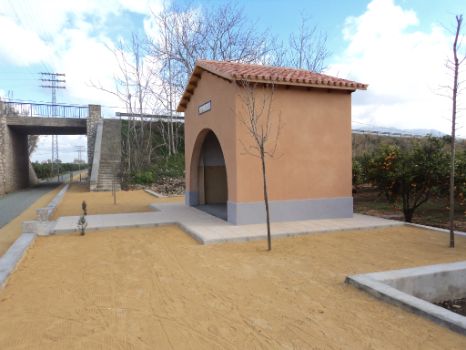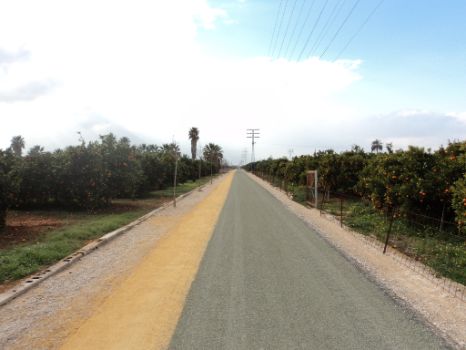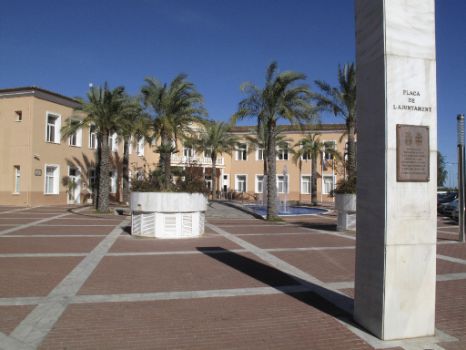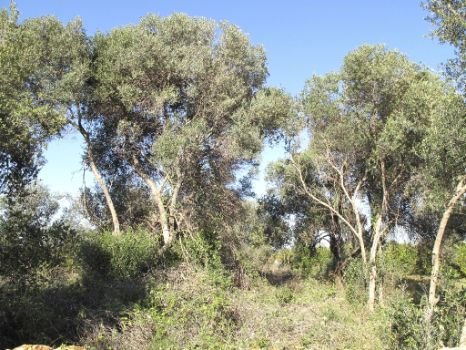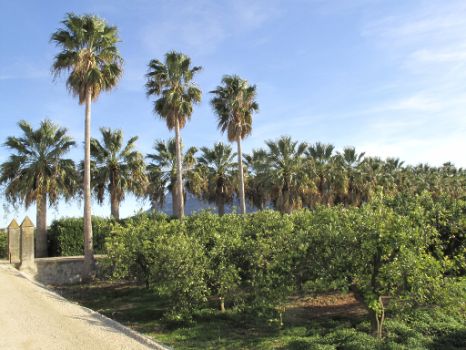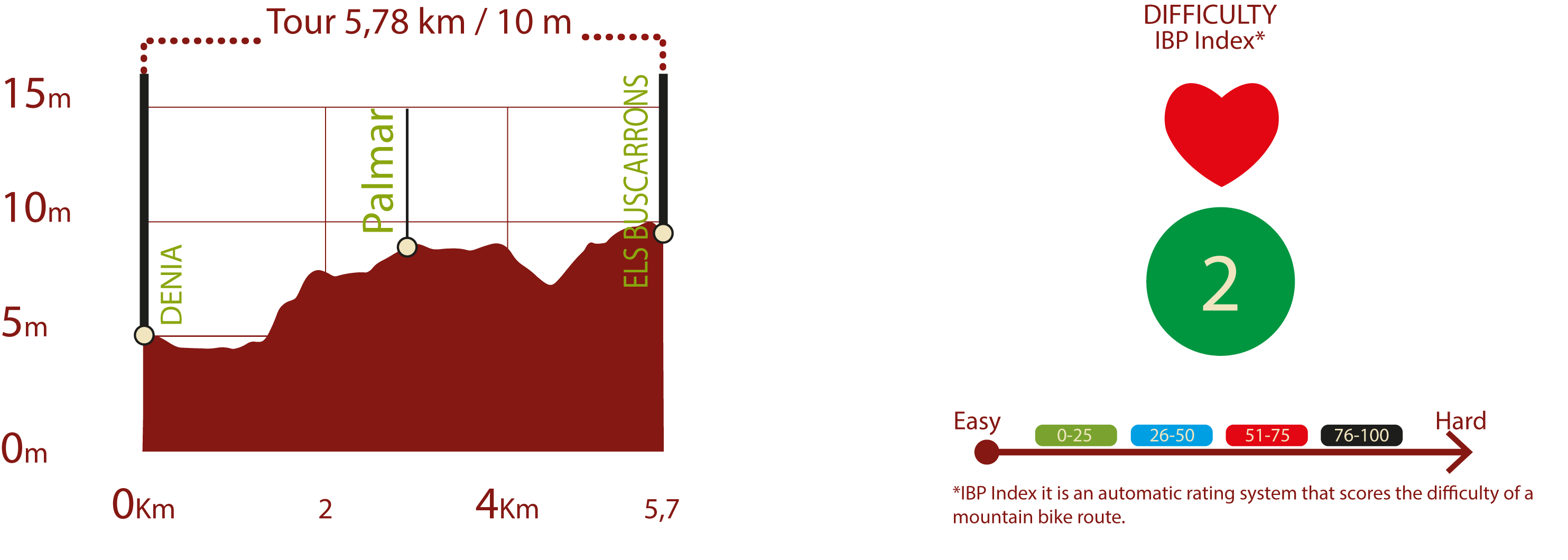Net of Natural
Trails

Dénia Nature Trail
Description
Among fruit and palm trees
The Dénia Trail follows the Carcaixent-Denia railway track. Originally, this narrow-track railroad, in disuse since 1974, operated with animal traction. Horse stables were located in strategic places so they could be replaced. For more elderly people in the area, the route evokes a past of moving memories of several generations who used this method of transport to travel to the coast. Over its six-kilometre route, you can see interesting farm scenery where the cultivation of citrus fruits plays a prominent role.
The Trail begins approximately 500 m from the town centre of Dénia, next to the remains of the old railway infrastructure. In order to reach the starting-point, you leave from the Avenida de Alicante in Denia, taking a north-westerly direction until you reach Calle Ondara and subsequently Carrer Negrasa, which ends next to the garden centre close to the origin of the trail.
At the beginning of the Trail, you will find a resting area outfitted with benches, tables and a healthy park where you can do physical exercise. Some 150 m from the beginning, you come to a black locust (Robinia pseudoacacia), a tree that is frequently used in gardening, characterised by its very resistant wood and poisonous leaves and fruit. If you carry on a little further, you will soon come to two walkways, which have a distance of fewer than 200 m between them. These types of walkways are frequent throughout the route, enabling trail users to avoid temporary water-filled riverbeds.
Following the Trail, and after crossing a typical corridor of palm trees that leads to an estate, you will pass on your left a beautiful farmstead which has at its entrance a monkey-puzzle tree (Araucaria excelsa), an interesting conifer that is frequently used in gardening. A little further on, you come to another recreational area where you can rest if you wish.
Continuing on your way, you will see on your right an old irrigation pond in disuse located on a plot that is no longer used for growing crops and, just after you pass a place where the path forms a crossroads with a tarmacked lane, you will come to an old deserted station, now converted into a cat kennels pertaining to the “Aldea Felina” Association.
Keeping straight ahead, you will pass on your right and some 370 m from the feline village, an unusual wall bordering an estate. A little further on, you will cross a walkway once again, after which you will see, on your left, an estate with two impeccable white houses and an old, well-preserved brick chimney.
From there, you will come to an underpass beneath the road from Alcalalí to the beach, where there is a good place to rest in the shade and to shelter on rainy days. Once you have passed this point, you will begin to see what is probably the tallest tree on the whole route. It is once again an extremely large monkey-puzzle tree with an unusual elongated shape, marking the location of a country garden house. If you carry on, you will come to another recreational area where you can enjoy the surrounding area.
It is impossible to get lost on this route which continues westwards crossing another corridor of palm trees similar to the one found at the beginning of the route. If you continue walking among the citrus fruit trees, you will come to a spot where you can see a hamlet with a well. At this site, a seasonal water course shapes an enclave with natural vegetation dominated by elm trees (Ulmus minor) and reeds (Arundo donax). You can also see a creeper known as the “cruel plant” (Araujia sericifera) which tangles itself up in the elm trees. It was given this name because its flowers have the unusual habit of trapping the butterflies that sip on them, holding them until the next day, although without killing them, hence guaranteeing effective pollination.
It is not an autochthonous plant but a subtropical, invasive creeper. This weed can also be seen on other parts of the route.
Crossing the previous riverbed over a red walkway, you get back onto the path again where, some 500 m further on, you will come to a group of wild olive trees (Olea europaea) and natural vegetation including blackberries (Rubus ulmifolius) and other creepers. At this point, you cross the Camí del Palmar to reach, some 270 m further on, the hut of the “Motor Virgen del Socorro” which has a large walnut tree (Juglans regia) in its vicinity.
Some 300 m from the end of the route, all that you have left to do to reach the end is to pass through another recreational area where you can regain your strength.
Although the Nature Trail ends here, it is worth discovering the geographical contrasts between the regions of La Marina Alta and La Safor, contemplating the unusual architectural heritage of the town centre of El Verger and visiting Marjal de Pego-Oliva Natural Park thanks to a network of bicycle lanes between El Verger y Pego.
Sites of interest
Puntos de interés
Culture
Hydrography
Infrastructure
Municipality
Orography
Hostel
Vegetation
Profile

Highlights
Further information
Els Bous a la mar
“Els Bous a la mar”, whose translation into English is “Bullocks into the Sea”, is held in Denia and is undoubtedly one of the most well-known and popular celebrations in the town. These festivities have been declared of National Tourist Interest since 1993 and are held during the second week of the month of July (practically coinciding with the Sanfermines of Pamplona) commemorating the Most Holy Blood.
In this bull running, the heifers leave the upper part of the town and run down to a rectangular bull ring, which is installed on the fishing quay and bordered by the Mediterranean Sea. In this way, when the bullfighters try to dodge the heifers, they often jump into the sea, as do the heifers themselves, which end up falling into the sea. When this happens, the bull is rescued by a boat especially designated for this purpose.
The true interest of these festivities lies in the unusual combination of a bull and sea spectacle and in which the heifers are not slaughtered. Furthermore, these festivities are open and popular in nature involving the participation of most of the inhabitants and many national and international visitors.
The traditional nature, the colours and the liveliness turn these festivities into a picturesque bull-fighting spectacle which is a must-see.
Dénia
Dénia is a town with a great historic tradition and the first findings of Iberian and Phoenician origin can be found on the Monte Montgó. The Phoenicians developed this port as a connection between the island of Ibiza, where there was an important trading port, and the peninsula. In this way, they succeeded in establishing even more trade routes in the Mediterranean together with other settlements on the east coast of Spain.
The Romans subsequently called it Dianium when it was declared “civita stipendiaria”, a designation that forced its settlers to pay tax as a punishment for resisting their conquest. In the Early Empire era, it became a “municipium” whereby its inhabitants were not regarded as Roman citizens but had similar rights and obligations as the Romans.
In the Visigoth era, around the 7th century, it was an episcopal seat under the umbrella of Toledo.
Under Muslim rule, it was called Daniya and became one of the capitals of the kingdoms of Taifa in the 9th century, which was an era of great splendour for the town.
After the Christian Reconquest, it became the domain of an earl and then a marquisate, where the most noteworthy Marquis of Dénia was the illustrious Francisco de Sandoval y Rojas known as the Duke of Lerma, King Felipe III’s favourite.
The municipality currently bases its economic development on the cultivation of citrus fruits and tourism, brought about by the enormous urban development that has taken place over the last century.
Multimedia
Downloads
GPS Downloads
Documents
Cyclability
PROFILE & DIFFICULTY
SAFETY RECOMMENDATIONS
-Caution on small road junctions and on section shared with motor vehicles.
GENERAL RECOMMENDATIONS
-Find out about the technical aspects of the route and the weather on the day.
-Take care of the environment. Take care not to disturb animals or damage vegetation. Respect private areas.
-You must give priority to pedestrians and comply with general traffic rules.
-The environment in which you will be riding is open, free to move around and an area where many activities are carried out (sporting, forestry, livestock and agricultural activities). Always have an understanding, prudent, responsible and respectful attitude.



